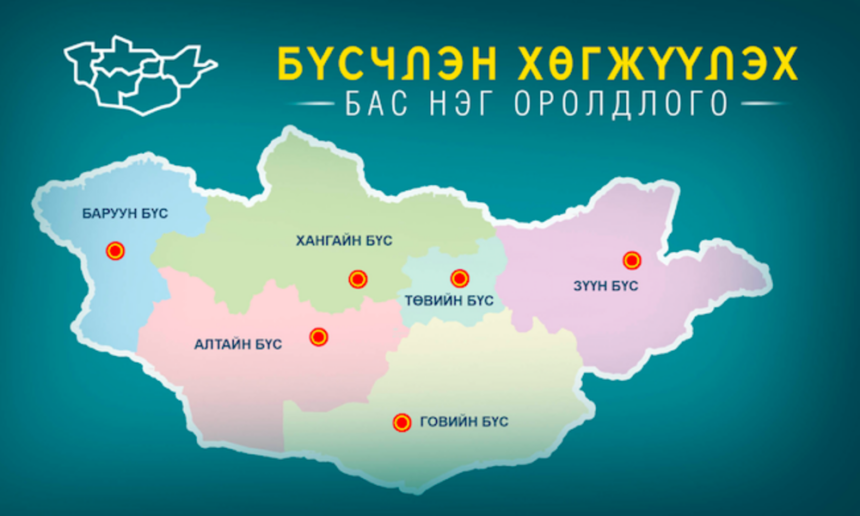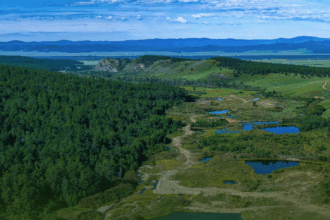(“THE VISION 2050” CRITICISM 6: THE REGIONAL DEVELOPMENT POLICY)
The Mongolian government is making another attempt to develop the country’s regions. The long-term policy document “The Vision 2050”, which is to be discussed by the Parliament, includes the special chapter ‘The Regional Development Policy’. It was proposed to establish the following six regions:
- Economic development axis, industry, tourism and green development of the eastern Mongolian region: Khentii, Sukhbaatar, Dornod;
- Responsible mining, high-tech production, services, and paleontological tourism region: Govisumber, Dornogovi, Dundgovi, Umnugovi;
- Natural resources, tourism, and green development region: Govi-Altai, Bayankhongor, Uvurkhangai;
- Economic development axis, Altai culture, natural resources and green development of the western Mongolian region: Khovd, Bayan-Ulgii, Uvs;
- Intensive farming, tourism, and green development region: Selenge, Darkhan-Uul, Orkhon, Bulgan, Arkhangai, Khuvsgul, Zavkhan;
- International science and technology center, transportation hub, high-tech production and service region: Ulaanbaatar.
Each region’s development plan is described, explicating the expected achievement scenario for every 10 years. At the beginning of the chapter, it was mentioned that the previously approved Regional Development Strategy (Parliament Resolution No. 51 of 2001) and the government’s programs for its implementation will expire in 2020, hence there is a need to develop a new one. Unfortunately, no assessment on the implementation process and the outcomes of the 20-year-old program was conducted. Thus, it is doubtful that, without understanding why the previous one was not implemented, the new one will be realized.
Reasons for regional development failure
The purpose of the previous regional development, as set out in the policy document, was “to resolve the over-centralization of the population and industries in the capital city and thereby reduce the gap between urban and rural areas”. Furthermore, it aimed “to accelerate the socio-economic development at national level; pursued to create favorable external and internal conditions by ensuring that our resources including land, natural resources, agriculture, and human capital are used efficiently, and in a manner that does not exceed the limits set by environmental capacity”.
However, we now, 20 years later, see that none of these objectives have been accomplished. Moreover, in Mongolia, a large area with a population density of two inhabitants per square kilometer, the countryside is being abandoned, whereas the capital is overcrowded with one-third of its only three million populations living in poverty. Can this be called development?
‘The Regional Development Strategy’ never found its way into reality mainly due to the fact that the areas uniting the certain aimags don’t have a region, nor have they been empowered to conduct budget, tax, credit, and investment policies. Read more about this in the article “Failed attempts of regional development”.
The initial regional development plans intended to divide the country into four longitudes: West, Khangai, Central Region, and East Region; and to develop Ulaanbaatar as an independent region. As you can see from the picture below, it did not succeed.
Fig.1: GDP by regions. 2001-2017 years. National Statistics Commission
The effects of uneven growth, which are local communities being noncompetitive, public services such as education and healthcare, and access thereof, being unequal, have resulted in the desertion of rural spaces and urban overcrowding. In the past 17 years, since 2000, half a million people have moved to Ulaanbaatar. Unless the country is not regionalized and equally developed, it is estimated that 80 percent of the population will move to the capital city in the next 30 years, instead of the current 50 percent.
Japan’s proposal
In 2016, the Japan International Cooperation Agency (JICA) conducted a study on the regional development of Mongolia and proposed connecting the regions to longitudinal and latitudinal axes. Along these axes, secondary and tertiary cities could be created besides the capital, and the centers of certain aimags could become pillar cities.
Fig. 2: The projection of the strategic Development Corridor of the economy of Mongolia
The main pillar of Mongolia’s countryside development is the agricultural sector, representing 34 percent of the total workforce of which 38 percent are located in Khangai, 24 percent are in the West, 22 percent are in the center, 11 percent in the East, and 5 percent are in the Ulaanbaatar region (National Statistics Office, 2018). This latitude axis region is expected to be the basis of green growth by supporting agricultural production through creation of value-added end products. In addition, regionalization should be based not solely on the features of aimags and localities, but as well on the economic characteristics of our two neighbours. According to the study, as economic cooperation between our two neighbours has expanded, especially in recent years, it is possible to intensify the longitudinal axis region.
Creating regional development
Since previous mistakes of ‘The Regional Development Strategy’ had not been taken into account in “The Vision 2050”, it is likely that another attempt will be made.
In order to successfully implement the regional development, it is right to consider JICA’s proposal to connect the regions along the longitudinal and latitudinal axes. However, the following three factors need to be changed first. These include:
- Electoral system
- Tax policy
- Investment, city and local bonds
The electoral system was majoritarian, except for 2012, thus stalling the regional development at the aimag level. In such way, without a proportional element in the electoral system, politicians will continue to view the country’s development at the aimag level, supporting only their constituencies while neglecting the regional development plan. For example, since the 2020 budget is based on such standard, it will be used to build monuments, buildings, and cultural centers in aimag and soumcenters. The zoning policy has failed as the authorities have been fighting to make their aimag the regional center. Therefore, an electoral system which will ensure equal representation of the population is necessary.
An overly centralized tax policy has been the major obstacle to local development. The government is interested in the accumulation of political and economic power. A clear example is the law which allows a portion of the royalties to be retained at the local level, however it has been poorly implemented. You can read about it in the 2019 article.
Investment financing needs to be allocated in line with the regional development policy and aimed at increasing the competitiveness of regional enterprises. In addition, attracting local and foreign investment is needed, and local communities can take the initiative. In order to do this, the local government can become a tax authority which will allow them to then issue local bonds. Find out more about the Muni bonds in this article.
Anyway, my motivation here was to give my take on “The Vision 2050” and provide constructive criticism, since it is being discussed by the public.
2020.04.02
Trans. by Riya.T and Sungerel.U












